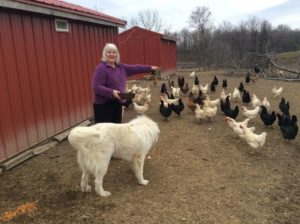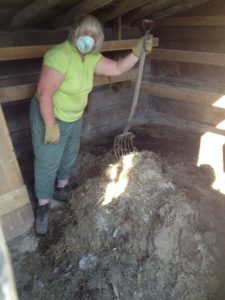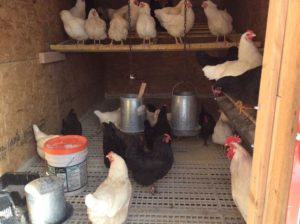Cleaning Out the Chicken Pen
October 3, 2016/
by Elaine J. Kennedy
“I won’t! I won’t! I won’t clean out another chicken pen,” I promised myself.
Desiring life on a small farm bored into our hearts and souls. As we considered retiring from life and work in Asia and knew that we would inherit a small farm of 50-acres, we researched small farms and read books until we concluded that we wanted a sustainable farm where we could raise healthy animals organically.
My husband bought beef cattle and installed fence; I wanted to have chickens. My husband didn’t want chickens because he didn’t want to have to chase them inside the pen every night. I told him, “When it’s dark, the chickens will naturally go inside the pen.” “No way!” he retorted. After it happened, he was pleasantly surprised.
A friend gave me my first chickens in 2013, a year after we retired. A week after the Estate Sale, Susan brought over 6 or 8 Americauna pullets and I didn’t have their house ready, so we put them into a clean old hog pen and found some straw. I wasn’t prepared…had no feeder and no water fountain, so I improvised with a short piece of gutter for a feeder. That worked!
Then we bought baby chicks (for meat chickens) and I had no brooder pen but we had an antique playpen that didn’t sell at the estate sale. Perfect!
When the hens started laying eggs, I wanted more hens. After all, why spend time feeding only 6 hens when I could have more? I began purchasing mature pullets from various sources and built up a flock of a variety of breeds, which I kept for two years. I sold white eggs, brown eggs, green eggs, blue eggs, pink eggs. People loved opening a carton of our eggs.
Our customer base for free range chicken eggs grew by word of mouth, and the workload was minor except for cleaning out the pens. The ex-hog pen was beside a creek and the chickens got their water from there, so we didn’t need to haul water. We only moved feed, gathered the eggs, and opened and closed the chicken house doors.
Occasionally, predators came into the area and scared the wits out of us! We did not like that fox that wanted to live in our hay shed right next to the chicken pen. And we did not like that cat-like wild creature with sharp teeth that curled himself up on an inside corner of the pen; that was one time when the chickens refused to go into the pen. Then there was that opossum that was sleeping in a nest, waiting for the next egg to be laid. We learned to carry a flashlight with us if we were caught closing the chicken house doors after dark. We were glad that we survived the predators without heart attacks.
At first, shoveling out the pen wasn’t bad, especially since we kept lots of straw on the floor. But then there was the winter of 2014-15, when the snow was so deep all winter long that I had to wait until Spring to get in there and do house-cleaning. By then, I was working with a foot of litter and straw to remove from that old pen. All that good compost! I cleaned out half the pen and my husband helped me with the other half of that heavy stuff.
As I shoveled, my mind went back to my father’s poultry farm of a thousand chickens, which was considered large in his time. He built a chicken house with the first ‘wooden’ slat floors and roll-out nests. While he ranged the pullets in shelters, after they started laying, he housed the hens in a large chicken house that had large separated pens inside. I always remembered his words, “Before I put chickens in cages, I will go out of business.”
Perhaps my father’s words impacted my desire to range our hens outdoors, and we wanted to range pullets and hens all year round. We began to dream and envision a movable pen with slat floors and roll-out nests—a pen for 60-80 hens. My poultry magazine showed slat floors that were being used on commercial farms, so I ordered panels of hard-plastic slats – not cheap, especially with freight shipping — but far better than my father’s wooden slats that broke easily.
I feared that the open floors would make the pens too cold for our minus-20F degree winter weather in the Upstate ‘Fingerlakes’ Region of New York State, so we insulated the pens. My husband is a great rough-carpenter, so he built the pens.
I shared my flock of older chickens with a niece who wanted her own ranged chickens, and I bought my own first flock of baby chicks that grew into pullets and hens—50 White Rock, 50 Black Australope, and 15 Americana so that our carton of eggs could continue to surprise customers with green and blue eggs mixed in with brown ones.
For the winter, we brought the pens close to a shed with electricity so that we could give the hens their required 16-18 hours of light for them to lay all winter long. We had placed the roll-out nests inside the pens for protection from the bitter cold. The nest boxes from a hatchery in Ohio came with rubber mats, so we use no straw. The eggs are spotlessly clean.
In the Spring, my husband hooked chains to the side bolts of the pens and with his tractor dragged them to a new area. He then used the loader on his tractor to scoop the manure into a lovely compost pile. That was easy! “I will! I will! I will clean out those chicken pens”—just by moving the pens!
Other than moving the chickens to fresh grasses, one other benefit of moving the pens is the feed that goes through the floor is scratched at and eaten as a ‘snack’ after the pen is moved.
We’ve now used the pens through one hot summer and one cold winter; they are perfect for our climates. The insulation keeps them cool in summer and warm in winter. I don’t know of anyone else that has a small flock of hens in pens with slat floors, but we totally recommend it.
I just bought 55 ‘Barred-Rock’ pullet-chicks as replacements for older hens, which I will do annually, to rotate new chickens in and out for continued egg production. And just when I think I know what I’m doing, some hens decide to molt and lay less eggs.
Life as a farmer is always a challenge! But at least I don’t have to clean out the pens anymore.
Elaine J. Kennedy is a retired small farmer who loves raising chickens the easy way and gathering eggs. For more information on slat floors and/or roll-out nest boxes, or for a desire to view our pens, please contact Elaine Kennedy at ejkenned@gmail.com.
Posted in Livestock & Dairy




